Most modelers consider the Dremel tool to be a must-have accessory for the workshop. They use them for any number of routine tasks, from trimming music wire to sanding, drilling, grinding and shaping. Many modelers I have talked to don’t ask their Dremels for much more than that though, and this is a shame. Like many tools, these wonders gain increased versatility with additional accessories. The two accessories I seem to use the most are Dremel’s #231 Shaper/Router Table and the #335 Plunge Router Base. Here are a few photos showing how I recently used these accessories to expand the tool’s basic functionality and improve my results while working on some foamie flying wings and a scratchbuilt quarter-scale sailplane.
PLUNGE ROUTER BASE
While building a few foam flying wings recently with some friends, we came up against the age-old question of how to “pocket” the wing cores to mount the servos. Usually we just trace around a servo with a knife then dig out the pocket. Someone even suggested melting a hole with a hot soldering iron and bedding the servo in hot melt glue. While these approaches work, you will probably need a good dose of hot melt glue or Goop to ensure the servos stay put. They also leave little accommodation for pride of craftsmanship, and add unnecessary weight. Instead, I offered up my #800 cordless Dremel tool in the plunge router base. I mounted the 5/8-inch guide bushing, included with the base, and chucked a 1/8-inch high-speed cutter.
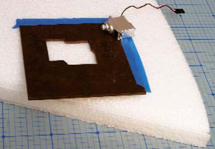 The template in place on the wing core. 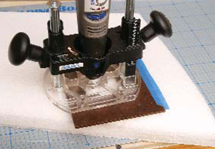 No secrets here, just follow around the template with the bushing against the template and rout out the middle afterward. 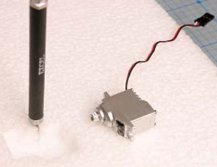 I manually cut slots for the mounting arms to keep everything snug. I also cut a slot for the servo lead that will later be extended to the receiver. |
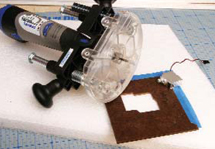 All the bits together. Note the guide bushing around the cutter. 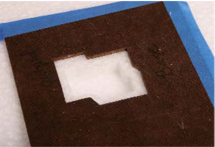 A perfect pocket. Note the 1/4-inch difference between the template and the pocket. 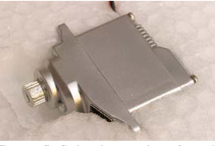 The servo fits flush to the outer wing surface and is held tightly by the surrounding foam. We used only the lightest bit of adhesive on the vertical faces of the pocket so we can slice the servo free later if needed. 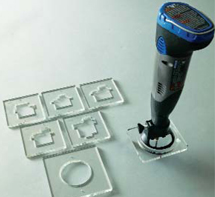 Available from Sky King Products, the Perecman Dremel router base and template system is manufactured from laser-cut acrylic and saves you the trouble of making your own templates for some common servos. |
I measured the bushing-cutter offset at 1/4- inch, and then made a hardboard template with a hole that mirrored the servo outline plus this offset. The easiest way to do this was to hold the servo down on the middle of the template stock with a scrap of double stick tape, and trace around it using a piece of 1/4-square stock to guide a pencil. Be sure to accommodate the output arm as you trace the outline. I used my scroll saw to make the cutout inside the line. By leaving a little extra material, I was able to fine-tune the fit of the servo into the pocket with a few strokes with a file. Filing closer to the line increases the size of the hole and eases the fit. Now set the bit depth to match the thickness of the template stock and the width of the servo.
With the depth set, I taped the template to a test block of foam and powered up the Dremel. I lowered the router base onto the template, and traced the outer perimeter using the guide bushing. Once I had the outline cut, I made a few side-to-side and foreand- aft passes across the middle of the pocket to clear the inner foam.
After just a few seconds, there was a perfect servo pocket and we moved on to the wings. Making the template only took a few minutes, and the results were well worth it. If this technique and its results appeal to you, but you don’t want to bother making templates, a very economical option is available via SkyKing RC Products. They offer an acrylic router base with guide bushing that attaches to the Dremel spiral-cutting base, and a set of acrylic templates for many popular servos. This base is much less complex than the Dremel accessory, and does not offer the flexibility of plunge routing.
For pocketing foam wings though, that is not a big concern. Our sample let us quickly cut pockets that are a snug fit for the intended servos without creating our own templates.
SHAPER/ROUTER TABLE
Another Dremel accessory that gets a lot of play in my shop is their Shaper/Router Table. I usually use this with sanding drums as a sanding table, but recently created a template for routing wiring holes and auxiliary bracing spar slots in balsa wing ribs.
Starting with a piece of 1/8-inch hardboard, I made a guide plate that holds the ribs in place by referencing the spar pockets. I then set the main fence so it would guide this template on one side, and clamped a secondary fence to guide the opposite. To maintain consistent length, I glued two spruce strips to the underside of the plate that limit its motion left and right as they reference the table edges. In operation, I simply place a rib on the jig, and then plunge the cutter through the rib by referencing the main fence. I now move the part clockwise around the cutter while sliding the plate against the fences and spruce strips. The actual time to cut each hole is something like 10 or 15 seconds, with uniform results and no tear-out as often occurs with a large drill bit.


Left: These strips of spruce reference the table edges. They are far enough apart to allow the jig to move the desired amount in line with the ribs. Right: I cut an access hole in a piece of hardboard, and Zapped on scraps of spruce as locators for the ribs. Note the auxiliary fence clamped onto the lower edge of the table. Plunge the rib down onto the cutter, then trace around the cutout assisted by the fences and guide strips.
Plunge the rib down onto the cutter, then trace around the cutout assisted by the fences and guide strips.
CONCLUSION: Most woodworkers appreciate how a router increases the productivity and accuracy of their work. What few would ever consider is removing the router motor from its base and using it hand-held. Yet this is exactly how we usually use our Dremel tools most of the time. Granted, they are designed for handheld use, but any hope at accuracy depends on your skill. By taking advantage of some additional accessories and basic jigs, you will find a new level of precision and many more uses for your Dremel; truly one of the most versatile tools in our workshops.

The final results are clean and consistent holes in the ribs for easy wiring access.
LINKS
Dremel, www.dremel.com, (800) 437-3635
SkyKing RC Products, www.skykingrcproducts.com, (612) 605-1128
 Fly RC Magazine WE LIVE RC
Fly RC Magazine WE LIVE RC
